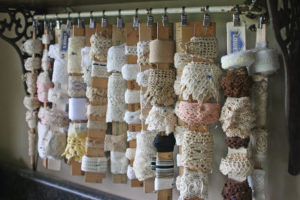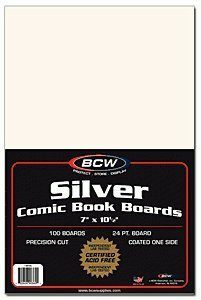Resolve to Get Organized this year! (part three)
Can you hang a shelf on the wall above the windows for seldom-used large items? Use it for PIGS (projects in grocery sacks), extra batting, those rarely used specialty rulers, your sewing machine manual, button jars, a dish rack, etc. The dishrack can hold little-used patterns, ribbon reels, Pigma pens and so on.

If your shelves have brackets, maybe you could connect a pole between the brackets to hang organizational elements as shown in the picture to the left from Attic Magazine. How about a hanging magazine rack or wall file folder for rulers? You could use a back-of-the-door type shoe organizer (or jewelry hanging bag) to help store threads, scissors, pencils, rotary cutter blades – anything you don’t want the cat to play with. Save the back of the door for two wreath holders. Place a dowel between them to hold fabric, tops or any WIPs. (works in progress)
You can put your magazines on these shelves, too. Buy a pretty box from a craft store (or paint one yourself) to hold your magazines. Empty detergent boxes work well, too, because they are sturdy, easy cover and usually have handles.
As you go through your magazine, put a post-it note or address label on the page with an interesting project. File the magazine so the note shows. Use Sticky Novels – a little book filled with tiny post-it notes, just perfect for marking your place in a magazine. It will help you find the project later. If there are no notes, don’t save the magazine. Give it to a quilting buddy or recycle it. If space is tight, you can tear out the pattern or idea, put it in a page protector, and save it in a three-ring binder.
Can you commandeer a closet? A custom closet solution will go a long way to solving storage woes. If not, you can always use a tackle box for small notions. A portable tackle tote has zipper compartments to hold small items and has the advantage of being able to fold up neatly so you can take it to class. It’s a great place to permanently keep items you will need for classes or retreats. Another useful item is a canvas storage container that collapses when empty. If you need ready access to the items in the closet, use curtains instead of doors.
If your space is really small, you can always put a sewing room in an empty double closet. Measure the depth of the closet, then buy a luan door that wide. Place it on top of two filing cabinets or short bookcases inside the closet and add shelves above and pegboard along the back for an instant, if mini, sewing room.
Fabric can be stored in any number of ways. The easiest is probably to put it in clear plastic bins, sorted by color, value, size or amount. Store those bins where you can see them!

If you would like your fabric on display, consider making mini bolts. Just fold your yardage in half lengthwise (selvage to selvage), then in half again. It should measure 10 or 11 inches. Wrap this yardage around your widest ruler, secure with pins, then slip the ruler out. Stack on shelves or in a bookcase so you can see them. If you would prefer a studier wrap, you could ask your local quilt shop for their bolt ends which you could cut down, or use a commercial acid-free cardboard like a Comic Book Board.
If you need to store fabric in a small space like an RV, consider hanging yardage on a multiple pants hanger. They will be in your closet and out of the way until you need them. Tabletop shoe organizers and CD organizers are the perfect size for fat quarter storage. Just fold them up and secure with a ponytail holder.
Small bits of fabric can be saved in organizers sorted by size or color but before saving anything, ask yourself, “Will I use this again?” Small scraps can be used as leaders and enders. If you get enough, you can make a lovely quilt, but will you? You know yourself best – if you know that you will never use a piece of fabric smaller than a certain size, toss it! Yes, you can always save it for that one person in the guild who will stuff dog beds for the animal shelter with them but if you don’t know that person, find a handy trash can and make friends with it. You want your sewing space to be a place of joy and relaxation, not a place of unfulfilled promises.
Determine a place for everything. Put everything away where it belongs and put it back when you are done with it. If you find that you are leaving certain items out all the time, change their storage area so they are more readily accessible. Or put a pretty basket by your sewing machine and keep frequently used items in it.
Have you found this article helpful? I kept track of all the tips you sent me, and more from facebook, and put them into an article on PhoebeMoon. You can read it here.

